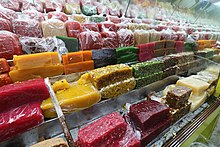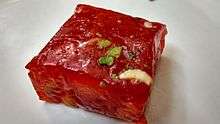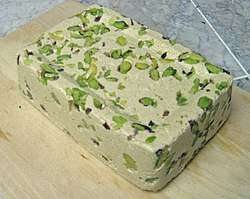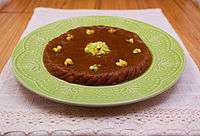Halva
Halva (also halvah, halwa,[1][2] and other spellings) are dense, sweet confections originating in the Middle East.[3][4][5] It is also popular in Central and South Asia, the Balkans, the Caucasus, Eastern Europe, Malta, North Africa, the Horn of Africa, and in the Jewish diaspora. Identical sweets exist in other countries, such as China, though these are not generally referred to as "halva".
 Halwa at Mitayi street Calicut | |
| Alternative names | halvah, halwa, etc. |
|---|---|
| Type | Confectionery |
| Region or state | Middle East, Central Asia, South Asia, Eastern Europe, Caucasus, North Africa, Horn of Africa |
| Main ingredients | Flour base: grain flour Nut base: nut butter and sugar |
In global, popular usage it means "desserts" or "sweet", and describes two types of desserts:
- Flour-based
- This type of halva is slightly gelatinous and made from grain flour, typically semolina (suji- India, Nepal and Pakistan). Its primary ingredients are clarified butter (ghee), flour, and sugar.
- Nut butter-based
- This type of halva is crumbly and usually made from tahini (sesame paste) or other nut butters, such as sunflower seed butter. Its primary ingredients are nut butter and sugar.
Halva may also be based on various other ingredients, including beans, lentils, and vegetables such as carrots, pumpkins, yams and squashes.[3]
It can be kept at room temperature during non-summer months with little risk of spoilage.[6][7]
Etymology
The word halva entered the English language between 1840 and 1850 from the Romanian Yiddish: חלווה, romanized: halva, which came from the Ottoman Turkish: حلوى helva, itself ultimately derived from the Arabic: حلوى, romanized: ḥalwá, a sweet confection.[8][9] The root in Arabic: ح ل و, romanized: ḥ-l-w, means "sweet".[10]
History
A reference to halvah appeared in the 7th century, referring to a mixture of mashed dates with milk. By the 9th century, the term was applied to numerous kinds of sweets, including the now-familiar sweetened cooked semolina or flour paste.[3][8]
Many of the earlier Persian recipes were documented in the 13th century Arabic book Kitab al-Tabikh (The Book of Dishes), as well as an anonymous cookbook from 13th-century Moorish Spain. Halva was adopted and expanded by the Ottoman Turks, including a sesame-based version, and spread throughout their empire.[8]
Types

Most types of halva are relatively dense confections sweetened with sugar or honey. Their textures, however, vary. For example, semolina-based halva is gelatinous and translucent, while sesame-based halva is drier and more crumbly.
Flour-based
Flour based halva is made by frying flour (such as semolina) in oil, mixing it into a roux, and then cooking it with a sugary syrup.
Semolina

This variety of halva is usually made with wheat semolina,[11] sugar[12] or honey, and butter or vegetable oil. Raisins, dates, other dried fruits, or nuts such as almonds or walnuts are often added to semolina halva. The halva is very sweet, with a gelatinous texture similar to polenta; the added butter gives it a rich mouthfeel.
In India, halva recipes use flour, melted butter or ghee, sugar and optionally acacia gum (gum arabic). It comes in various colors like orange, brown, green and white; in a translucent appearance studded with raisins, cashew nuts, pistachios, almonds, etc. Technically- the term halva is used in native recipes throughout India. A prominent South Indian version of halva (or alvaa in Tamil) is from Tirunelveli, a city in the state of Tamil Nadu. Another semolina preparation widely enjoyed throughout South India called kesari or kesari-bath originates from the state of Karnataka.
Alternative vegetable-based halva recipes popular in India and Pakistan use beetroots, potatoes, yams, and most commonly carrots (for gajar halwa), mung beans (for moong dal halwa), or bottle gourds (for doodi halwa) instead of semolina. Prepared with condensed milk and ghee, without semolina to bind it together, the end result has a moist, yet flaky, texture when freshly prepared. Other examples include the famous Agra Petha, easily available at Taj Mahal, Agra.
Cornstarch
Cornstarch-gelatinous halva is popular in Greece and has many variations.[13]
Rice flour
This rice flour and coconut milk halva is common fare on the streets of Zanzibar.
A dairy-based rice flour halva, known as Pathein halawa, is considered a Burmese delicacy native to Pathein.
Nut butter-based

This type of halva is made by grinding oily seeds, such as sesame or sunflower seeds, to a paste, and then mixing with hot sugar syrup cooked to hard-crack stage. This type is popular in the Mediterranean, the Balkans, Middle East, Central Asia, and Eastern Europe.
Sesame
Sesame halva is popular in the Balkans, Poland, Middle East, and other areas surrounding the Mediterranean Sea. The primary ingredients in this confection are sesame butter or paste (tahini), and sugar, glucose or honey.[3] Soapwort[14][15] (called ‘erq al halaweh in Arabic; çöven in Turkish), egg white, or marshmallow root are added in some recipes to stabilize the oils in the mixture or create a distinctive texture for the resulting confection. A version of sesame halva, called sesame crumble candy (芝麻酥糖) in China uses ground sesame and sugar, cooked to the hard ball stage because it is made crispier than other halvas. Other ingredients and flavorings, such as pistachio nuts, cocoa powder, orange juice, vanilla, or chocolate are often added to the basic tahini and sugar base.[3][16]
Sunflower
Sunflower halva is popular in the countries of the former Soviet Union, but also in Bulgaria, Romania, Serbia, and other Balkan countries.[17] It is made of roasted ground sunflower seeds instead of sesame. It may include other ingredients, such as nuts, cocoa powder, or vanilla.[18][19]
Other
Floss halva
Pişmaniye (Turkish) or floss halva is a traditional sweet, prepared in Kocaeli, Turkey, made by flossing thin strands of halva into a light confection. Made primarily of wheat flour and sugar, the strands are continuously wrapped into a ball shape and then compressed. The result is a halva with a light consistency, similar to cotton candy. Floss halva can be found in regular and pistachio flavors, and there are brands with halal or kosher certifications.
A similar pistachio-based version of floss halva is popular in North India. It tends to be slightly denser and is often referred to as patisa or sohan papdi. In Chinese cuisine, a floss-like candy similar to pismaniye or pashmak halva, known as dragon beard candy, is eaten as a snack or dessert.
A raw version of halva also has become popular among proponents of raw food diets. In this version, a mixture of raw sesame tahini, raw almonds, raw agave nectar and salt are blended together and frozen to firm.[20]
Cultural use
Halva can be a snack or served as part of a meal.[1]
Azerbaijan
One regional variant is from Sheki where Şəki halvası halva refers to a layered bakhlava style pastry filled with spiced-nut mix and topped by crisscrossed patterns of a red syrup made from saffron, dried carrot and beetroot.[21][22]
Greece
Halva is a traditional fasting food among Greek Orthodox who traditionally have food restrictions, especially from meat, on Wednesdays and Fridays throughout the year, for all of Great Lent and other fasting periods.[23]
India

India has many types of halva, some unique to particular regions of the country. It is one of the popular sweets of India usually made from semolina.[24]
It is speculated that Halva (or Halwa) is associated with Muslims in India, but written records of sweets from Mānasollāsa indicate that semolina halvas, the most popular form of halvas in India, were already known in India, for instance, it mentions a sweet called shali-anna which is a semolina based sweet today known as kesari bat.[25]
Various types of halva from India are distinguished by the region and the ingredients from which they are prepared. In northern India, the most famous include sooji (or suji) halva (semolina), aate ka halva (wheat), moong dal halwa (mung bean halva), gajar halva (carrot) which traditionally belongs to Punjab and is referred to as gajrela, dudhi halva, chana daal halwa (chickpeas), and Satyanarayan halwa (variation of suji halwa, with the addition of detectable traces of banana), and kaju halva (cashew nut). Kashi halva, made from winter melon or ash gourd, is a famous and traditional sweet of Karnataka, and mainly makes a regular appearance in traditional Brahmin weddings. Sooji halwa is sold in many eateries in Karnataka as Kesari bhath, usually alongside pineapple. "Aate ka Halva" usually being served every day as "Prashad" after reciting hymes in Sikh Gurudwaras.
Tirunelveli in Tamil Nadu is known for its wheat halwa. Its preparation is a laborious process that "is slowly seeing this sweet disappear." Unlike other sweets, the extra ghee is not drained out but forms an outer layer. This increases the shelf life of the halwa. The unique taste of the halwa is attributed to the perennial Thamirabranai.[26]
The history of Kozhikodan Halwa in Kerala could trace back to Zamorin era. Zamorin invited chefs from Gujarat to prepare halwa for their royal feast[27]. They were also granted places to stay beside royal kitchen. This settlement later evolved as sweet sellers street, nowdays known as SM (Sweet Meat) Street or Mittayitheruvu[28]. Kozhikodan halwa is made of pure coconut oil, not from ghee. Significant Arab and Middle Eastern influence in Kerala contributed to the Karutha Haluwa (black haluwa), made from rice, is very popular[29]. Kozhikodan halwa also builds religious harmony, Ayyappa devotees from neighboring statesKarnataka, Andhra Pradesh are buying halwa and chips like prasadam (Sacred food). They distribute them among their neighbors and friends, who consume them with a religious zea.[30]
Iran

In Iran, halva (حلوا) usually refers to a related confection made from wheat flour and butter and flavored with rose water.[31] The final product has a dark brown color. The halva is spread thin on a plate till it dries into a paste. Halva usually is served at funerals and other formal ceremonies, often with almonds or coconut shavings on the top.
Halva Ardeh is the Iranian term for tahini-based halva, and may or may not include whole pistachios. Ardeh is processed sesame in the form of paste, usually sweetened with syrup.[32][33]
Israel
.jpg)
Tahini halvah (Hebrew: חלווה) is very popular in Israel and among Jewish people throughout the diaspora.[34][35] Spelled "halvah" in English, it usually comes in slabs, nearly-cylindrical cakes (illustrated), or small packages, and is available in a wide variety of flavours, chocolate and vanilla being very common. The halvah is almost always parve. Israeli halvah will usually not contain wheat flour or semolina, but will contain sesame tahini, glucose, sugar, vanilla and saponaria officinalis root extracts (soapwort), which are not usually found in other recipes. It is often served as a breakfast component at Israeli hotels, though it is not usually part of an Israeli breakfast, and it is even used in specialty ice-cream.[36]
United States
Halva can be found in ethnic Indian, Jewish,[8] Arab, Persian, Greek,[13] and Turkish community stores and delicatessens. It is increasingly offered by upscale restaurants in some areas.[37] Besides being imported, it is manufactured in the United States, with the largest producer being Brooklyn-originated Joyva.[5][1]
Cultural references
In Afghanistan, Turkey and Iran, after the burial ceremony, on the seventh and fortieth day following the death of a Muslim, and also on the first anniversary, semolina halva or flour halva is cooked and offered to visitors and neighbours by relatives of the deceased.[38] to commemorate the anniversary of death. For this reason, flour (un) halva is also called in Turkish ölü helvası, meaning "halva of the dead". The expression roasting the halva of someone suggests the person referred to died some time ago. In episode 46 of the Turkish TV series Winter Sun (Kış Güneşi), İsmail tells a joke:
- "Why do we always eat Halva after a meal of fish?[38]
- ... "So the fish knows it is dead and gone!"
_Samarkand%2C_Siyab.jpg)
See also
References
- Clark, Melissa. "For Halvah, Use 1/2 Cup Nostalgia". NYTimes.com.
- "Halwa vs. Halvah: An Investigation". June 8, 2017. Retrieved March 8, 2019.
- Davidson, Alan (1999). The Oxford Companion to Food. Oxford: Oxford University press. p. 378. ISBN 0-19-211579-0.
- Sharar, Abdul Halim (1994). Lucknow: the last phase of an oriental culture. Oxford University Press. p. 165.
- DeLafuentenov, Charles (November 8, 2004). "A Longtime Brooklyn Company That's Known for Its Sesame Sweet". The New York Times.
- Szokovski, Miriam. "How to Make Halva at Home".
- during hot summer months, it is better kept refrigerated, as it can turn runny after a few days.
- Marks, Gil (2010). "Halva". Encyclopedia of Jewish Food. HMH. ISBN 9780544186316.
- Halvah, Random House Dictionary, 2009
- "American Heritage Dictionary". Retrieved February 21, 2019.
- "Greek Halva". BBC Good Food.
.. semolina based Greek halva
- Tremblay, Pinar (May 18, 2015). "Semolina halva unites Turks in times of joy, sorrow". Al Monitor.
- Bella, Peter (March 6, 2014). "Making halva". Chicago Now.
.. famous Greek recipe .. town of Farsala .. corn starch instead of flour
- Arndt, Alice (1999). Seasoning Savvy: How to Cook with Herbs, Spices, and Other Flavorings. Taylor & Francis. p. 215. ISBN 978-1-56022-031-2.
- Halva Ethnological Museum of Thrace Archived July 3, 2007, at the Wayback Machine
- "HALWA+WITH+PISTACHIO" "Halwa with pistachio". FAO Food and Nutrition Paper. Food and Agriculture Organization of the United Nations. 25-28. 1982.
- Comparison of three sunflower halva assortments from Romanian market
- "Халва. Общие технические условия", ГОСТ 6502-2014, Межгосударственный совет по стандартизации, метрологии и сертификации, 2014 ["Halva. General specifications", Interstate Standard GOST 6502-2014 (in Russian), Euro-Asian Council for Standardization, Metrology and Certification, 2014]
- "Халва". ГОССТАНДАРТ. ["Halva" (in Russian). GOSSTANDART.]
- Amsden, Matt (2006). RAWvolution: Gourmet Living Cuisine. HarperCollins. ISBN 978-0-06-084318-2.
- How to make Sheki Halva, and its folk history
- Sheki Halva recipe (in Azerbaijani)
- Bahadur, Om Lata (1996). The book of Hindu festivals and ceremonies (3rd ed.). New Delhi: UBS Publishers Distributors ltd. p. 172. ISBN 81-86112-23-5.
- "Full text of "Indian Food Tradition A Historical Companion Achaya K. T."". archive.org. Retrieved January 30, 2019.
- Rajagopalan, Ashwin (May 10, 2018). "Tirunelveli Halwa: Tamil Nadu's Legendary Red Wheat Halwa You Need to Try". NDTV Food. Retrieved August 20, 2019.
- "kozhikode-calicut-halwa-food-history". www.onmanorama.com.
- "a-sweet-place-in-their-hearts". www.thehindu.com.
- "Black Halwa". www.deccanherald.com.
- "kozhikodan-halwas-religious-flavour". www.thehindu.com.
- Recipe
- Floor, Willem M. (2003). Traditional Crafts in Qajar Iran (1800-1925). Mazda Publishers. ISBN 9781568591476.
- Ying, Chris; Redzepi, René (2018). You and I Eat the Same: On the Countless Ways Food and Cooking Connect Us to One Another (MAD Dispatches). 1. Artisan Books. ISBN 9781579658564.
- Marks, Gil (1996). The World of Jewish Cooking. Simon & Schuster. p. 210. ISBN 978-0-684-82491-8.
- Ha'aretz Online: Four stops for Halva
- Ha'aretz Online: The Ice Man Cometh
- Moskin, Julia (April 11, 2016). "Sesame Extends Its Sweet Reach Beyond the Middle East". The New York Times. ISSN 0362-4331. Retrieved October 25, 2017.
- Tremblay, Pinar (May 18, 2015). "Semolina halva unites Turks in times of joy, sorrow". Al Monitor (Turkey). Retrieved August 20, 2019.
If you serve fish, semolina halva is a given
| Look up halva in Wiktionary, the free dictionary. |
